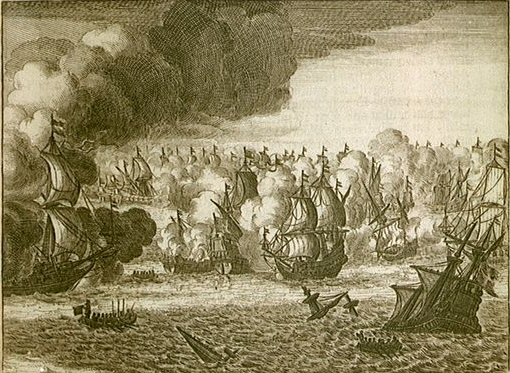
I’m currently transcribing the earliest register for Ramsey St. Michael in Essex. Although the very early register is lost, entries survive from 1645 onwards. I was intrigued to see if Ramsey was as affected by the plague of 1665 as had neighbouring Great Oakley. There certainly appear to have been an increase in burials that year, particularly in August, September and October – this is the same period as plague deaths were noted in Great Oakley’s register.[1]At this point, there’s about twelve burials a year in the Ramsey register. In just those three months of August, September and October, there were ten burials, and those three months are also … Continue reading But there’s no notes in the Ramsey register, so we can’t say for sure what those people died of.
But moving into 1666, something unusual appears. From 5th August to 26th August, the Ramsey parish register records the burials of nine sailors. By why?
5th August Jeremie Bignol, seaman of the ship the Bristoll
6th August Peter Cripp, seaman of the ship the Vangarde
7th August Thomas Chapman, seaman of the ship the Marie
7th August Steven Green, seaman of the ship the Yarmouth
9th August Richard Liberd, seaman of the ship the Bristol
10th August John Baxter, seaman of the Advice
12th August John Rayner, seaman of the Tyger
19th August John Skeech, seaman of the Cambridge
26th August Frances Jinckins, seaman of the Cambridge
At first I wondered if there had been bad weather in August – Ramsey is on the River Stour and the North Sea, right beside Harwich, so it’s no surprise to see sailors appear in the register. But why would a storm rage for over a month?
A bit of digging brought up the fact that, while we might associate the 1660s with the Restoration of the English Monarchy, the Great Plague and the Great Fire of London, England was in fact at war with the Dutch. It was the Second Anglo-Dutch War, which was apparently prompted by rivalry over the slave trade. What became known as The St. James’ Day Battle to the English, and the Two Days’ Battle to the Dutch, was fought on the 25th to the 26th July 1666 (or, for the Dutch, operating on the Gregorian calendar which the British wouldn’t adopt for another century, the 4th and 5th August). The British were moored off North Foreland in Kent, near the mouth of the River Thames, and the Dutch were moored off Orfordness in Suffolk; the battle, it would seem, was fought off the Essex coast. The English won and peace negotiations began, which would hopefully bring the war to a close.

A list of the ships involved in this battle can be found at Three Decks – and you’ll see that all the ships which are mentioned in Ramsey’s burial register are listed. It’s quite possible that the ships had been damaged during the battle, and had limped from the site of the battle to the naval shipyard in Harwich for repairs, or they were moored along the coastline of the River Stour or the North Sea, which falls within Ramsey’s parish boundary. It is always very interesting when the humdrum routine of a parish register, with its births and deaths of locals, is interrupted by the world outside, be it pestilence or war, impinging on the lives of people going about their ordinary business.[2]Unfortunately, Harwich’s burial register is patchy after 1665, and Dovercourt’s covering the same period has been lost, so there may have been many other casualties from this battle who … Continue reading
Those nine sailors buried in Ramsey in August 1666 were presumably injured in battle. Rather than be buried at sea, they were laid to rest in the earth – but where they were originally from, and whether their families ever visited their graves, we shall probably never know.
Footnotes
| ↑1 | At this point, there’s about twelve burials a year in the Ramsey register. In just those three months of August, September and October, there were ten burials, and those three months are also the same period for plague deaths appearing in Great Oakley. |
|---|---|
| ↑2 | Unfortunately, Harwich’s burial register is patchy after 1665, and Dovercourt’s covering the same period has been lost, so there may have been many other casualties from this battle who were buried in this part of Essex. |
